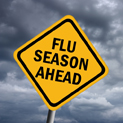
We hear the terms epidemic and pandemic tossed around, but do people know the difference? We hear it mostly describing outbreaks of the flu. A flu epidemic occurs yearly because the same virus returns, just slightly different. In a flu pandemic, a much larger area is affected, sometimes worldwide, when a new viral strain infects people and everyone is at risk.
There are three periods of pandemics. The first is the Inter-Pandemic period when no new influenza virus is in humans, but could be in animal populations. Next is the Pandemic Alert period where the virus is infecting humans but is either incapable or inefficient at human to human transmission. The last phase is the Pandemic period where there's rapid, widespread transmission.
A flu virus capable of causing pandemics starts with its ability to infect different animal species including horses, pigs and birds. As strains of the virus spread from species to species, multiple strains can infect one animal, exchange genetic information and create a whole new virus. Once it can infect and transmit between humans, a pandemic begins. The 1918 Spanish flu pandemic killed up to 40 million people worldwide.
Today, the H5N1 avian flu threatens to be the next pandemic. Since it was first identified in 1997, it has spread from Asia, and through the Middle East, Africa and Europe. Just over six hundred people have contracted the virus from domesticated animals and a staggering sixty percent died.
In order to understand how this virus may one day attain transmission between humans, U.S. and Dutch scientists created a transmissable version in the lab. The controversial study is aimed at creating a vaccine when a flu pandemic occurs.
But others fear the research could provide a "blueprint" for a biological weapon. The debate continues as scientists push to prepare for this lethal virus.
More Information
Bird Flu Paper Is Published After Debate
From the New York Times: "The more controversial of two papers describing how the lethal H5N1 bird flu could be made easier to spread was published Thursday, six months after a scientific advisory board suggested that the papers' most potentially dangerous data be censored."
H5N1: Bird Flu Pandemic May Be Closer than Thought, Study Finds
From Time.com: "It may take as few as five mutations for H5N1 to go from being a bird-only problem to a potentially deadly human pandemic flu, researchers report."
The Influenza Pandemic of 1918
Stanford University offers this comprehensive look at the influenza pandemic of 1918-1919, otherwise known as "Spanish flu" or "La Grippe", which killed somewhere between 20 and 40 million people.